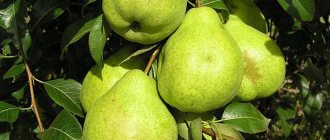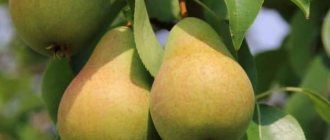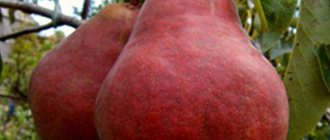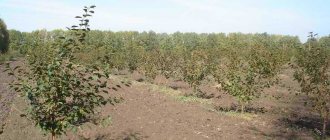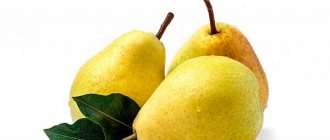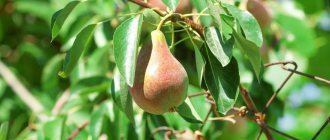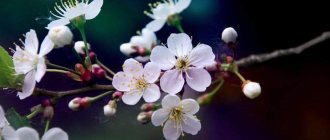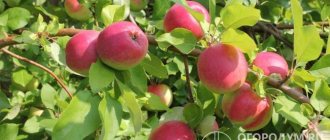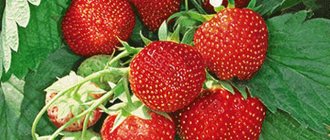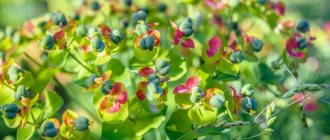Characteristics of pear fruits
The description of the variety states that the fruits are large, more than 200 g. Judging by the reviews, it is possible to grow a Tavricheskaya pear fruit up to 500 g. The photo shows that this is quite possible, but it will require effort and diligent care for the tree.
The shape of the fruit is ovoid, the surface is bumpy. The skin is moderately dense, rich yellow in color, with a characteristic pink side. The pulp is creamy, grainy, juicy. The taste of the fruit is sweet and sour.
The Tavricheskaya variety is suitable for all types of processing and fresh consumption. It makes delicious compotes, jams, and dried fruits.
Important! The Tauride pear holds well on the branches, does not fall off, and can easily be transported.
The harvest ripens at the end of September. The variety has good keeping quality. At a temperature of +2°C, pears are stored until mid-January. After picking, the fruits can be ripened at home; they quickly gain flavor and oiliness.
Description of the variety
Pear is included in the group of autumn ripening varieties. Trees of this variety can withstand temperatures down to -30 degrees and are suitable for growing in warm and temperate climates.
Characteristics of wood
The tree is low-growing and reaches 3 meters in height when mature. The crown is medium dense and has a pyramidal shape. The leaves are green, round in shape. The surface of the leaf plate is smooth, with a characteristic shine.
Description of fruits
Tavricheskaya pear variety.
Pears are large and the average weight of one fruit is about 250 grams. Individual specimens can reach a mass of 600 grams.
The main color of the fruit is bright yellow. There is a diffuse pink blush on the sunny side of the pear.
The fruits are juicy, sweet and sour, with a pleasant spice and oiliness in taste.
Fruit maturity occurs in the third decade of September. Harvested pears retain their consumer qualities until February, provided that storage is properly organized.
Pros and cons of the Tavricheskaya variety
The Tavricheskaya variety has several advantages:
- large fruits;
- excellent taste;
- versatility of use;
- precociousness;
- high productivity;
- frost resistance;
- drought resistance.
There are practically no disadvantages to pears. The only negative is that the fruits become smaller due to the abundant harvest. Standardization of ovaries is required. Although some gardeners do not consider this a significant drawback. In addition, the variety is demanding on fertilizing. Without proper care, it will not be possible to grow large fruits.
Tauride pear: characteristics of the variety, basic recommendations for planting, care, storage
“Tavricheskaya” is an unpretentious variety of pear, according to the description, producing large, tasty fruits. At the same time, according to the observations of gardeners, the yield of the tree only increases from year to year. Let's consider the advantages and disadvantages of a fruit tree: how to plant and care for it correctly, what to do if it is infested with pests, how to prepare for winter.
Botanical characteristics and description of the variety
Frost-resistant late variety that tolerates very low winter temperatures well
“Tavricheskaya” is a late frost-resistant pear variety that can withstand temperatures down to -30°C. This hybrid is the result of crossing the Bere Bosk varieties with Dikanka Zimnaya.
The plant has the following features:
- self-pollinates with quince, which is its important distinguishing characteristic;
- blooms in May;
- produces a harvest in the third year when planted with seeds, in the fourth year when crossed with quince.
Description of the variety:
- flowering deciduous tree up to 3 m high;
- foliage – dense;
- crown – compact, pyramidal;
- fruits are ovoid, oval-conical with a bumpy surface (weight - 200 - 600 g);
- the skin is thick, bright yellow with pink sides;
- The pulp is soft creamy, grainy, juicy.
The transportability of the pear is good. The fruits will not fall off the branches even after full ripening, and will not lose their presentation during transportation. If you harvest in late September and store it properly at positive temperatures, the fruits will last until the end of January without spoilage.
According to reviews from gardeners, it is possible to grow fairly large fruits weighing 500 - 600 g. Moreover, they will continue to gain an oily taste after harvesting when ripening at home. Although to achieve such a result you will have to work hard, ensuring impeccable care throughout the season and proper storage.
Pros and cons of the “Tavricheskaya” variety
Tauride pear, like other winter varieties, has its own advantages:
- Self-fertility.
- Resistance to drought, low temperatures in winter, long-term storage and transportation.
- Ripening of large fruits with impeccable taste.
- Low susceptibility to bacterial burn, scab.
The downside is that the pear can get mononucleosis and be affected by wasps. It is important to carry out preventive work in a timely manner, spraying the crown and leaves of plantings with insecticides.
Planting and caring for pears
Caring for this variety of pear is practically no different from caring for other fruit trees.
Main conditions for landing:
- The soil is loose, allowing air and moisture to pass through. You can add a little clay to retain fluid at the roots.
- The place is lit, not sultry. Mainly in the garden - in the west, southwest. The air near the root system should be saturated with water vapor. Otherwise, the pear will wither, despite the fact that it loves water.
- It is best to plant in the fall. The top fertile layer of soil is dug up and organic matter is poured into the hole. You can add wood ash and lime if the soil is acidic.
- It is worth filling the soil mixture to the very edges of the hole, making sure to pour plenty of water around the tree trunk.
- When the water is absorbed, you can place mulch around the circumference of the seedlings.
It is not recommended to place fresh manure in the planting hole. It can cause root damage during prolonged decomposition.
Caring for a pear tree is similar to caring for an apple tree. Young seedlings are fragile, so during the winter they need to be insulated by covering them with snow and wrapping them with film, paper, and straw.
The pear tree trunks should not be allowed to become overgrown with weeds. This means that it is wise to plant green manure - lupine - on the plot. In the spring, dig up the soil with it to cleanse and increase fertility.
How to choose quality planting material
Two-year-old seedlings have the highest chance of further growth when transplanted
Young seedlings of two years old take root most quickly.
Roots as planting material should be:
- elastic, strong, moist;
- without damage to the trunk, growths, peeling of bark, mold, wormholes and dead areas;
- with a trunk thickness of at least 3 cm, a developed root system, many small roots and several branches 2-3 cm in diameter.
You can check the degree of moisture in fine roots by wrapping them around your finger. They should bend well and not break. If you break the root, the ideal wood inside is green or white.
It is recommended to buy pears from fruit nurseries. Disease-infected seedlings are often sold in markets.
Watering and fertilizing
The first time after planting, it is worth watering the soil around the seedling generously
After planting, the seedling should get stronger. At first, it is worth watering abundantly, but not allowing the soil to become waterlogged. If the weather is dry, then you can pour up to 10 liters of water once a week under each tree. If it rains, no watering is carried out. It is enough to loosen the soil around the circumference of the trunk, preventing rotting of the root system.
When the seedlings become stronger, you can water them more often. During drought - 4 times per season. The last time is to generously saturate the tree with moisture in late autumn.
Seedlings are not fertilized immediately after planting. The soil in the hole should already be thoroughly fertilized. It is worth feeding the pear next spring.
To do this you need:
- mix urea, salt, water;
- add a little urea or chicken manure.
Once a year, you can water the pear with a solution of nitroammophoska; you can add potassium fertilizer and nitrogen once every 2-3 years.
When watering, it is important to take into account the climatic features of the area. If the pit is well fertilized when planting, then no fertilizing is carried out in the first year. In subsequent years, it is important to nourish the pear, otherwise the tree will become sick and the fruits will grow small.
Harvest and storage
The fruits of this pear variety are harvested in early October. Although you can postpone the dates, leaving the fruits on the branches until fully ripe, or picking them earlier when unripe. This is important for long distance transportation. This variety is transportable, so it will not lose its presentation for a long time and will gradually ripen.
When storing, it is important to create an appropriate temperature regime for the pear. Place the fruits in special pallets with recesses for each fruit. Equip the containers with limiting legs so that the upper racks of fruit do not overlap the lower ones.
Similarities between Dikanka and Tavricheskaya pear varieties
If you compare the Tavricheskaya variety with the Dikanka pear, you can notice some similarities:
- Trees of medium vigor, well leafed.
- Dikanka variety with good winter hardiness, this is also noted in the description of the Tavricheskaya pear.
- The fruits of Dikanka are large, even slightly larger than those of Tavricheskaya. With good care they reach 700 g.
- Both trees bear fruit abundantly, but the pears become smaller in the harvest year.
- The varieties Dikanka and Tavricheskaya belong to late summer varieties. Ripen in late September or early October.
- Trees are demanding on soil and growing conditions.
- The fruits of both varieties are well stored and transported.
Based on these characteristics, we can conclude that the Dikanka variety transferred only its best qualities to the Tavricheskaya pear.
Characteristics of the variety
Knowing the characteristics of growing a crop allows you to choose the optimal variety for the garden. The Tauride pear is zoned in the Crimean region, but its cultivation is possible in other regions.
Drought resistance, frost resistance
The tree tolerates low temperatures well, maintaining viability at -28-30 °C. The variety is also characterized by high resistance to periods of drought and other adverse weather conditions.
Pollinators
The peculiarity of the pear is that it is self-fertile, so there is no need to plant additional pollinators nearby. But the highest crop yield is observed if the following varieties are grown nearby:
- Maria;
- Emerald;
- The highlight of Crimea.
When planting trees in the neighborhood that are suitable for their flowering period, the amount of ovary on the Tavricheskaya pear increases to 50%.
Productivity
Fruiting of the Tauride pear occurs 3-4 years after planting in the garden. The first harvest will be presented in the form of 2-3 fruits, but gradually the number of ovaries increases. The ripening process begins in the second half of September and continues through the first weeks of October. Dates vary depending on weather conditions.
From the fifth to tenth years of life, up to 30 kg of pears can be collected from a tree, later this figure increases to 90-120 kg per season.
Important! The lifespan of the Tavricheskaya pear is 15-20 years; there are specimens of trees that remain viable for up to 30 years.
Application area
Taste qualities suggest eating the fruit fresh, but the pear variety is excellent for making compotes and jam. You can use pears to prepare dried fruits.
High yields allow the fruits to be used for sale: the fruits tolerate transportation and long-term storage well without losing their presentation.
Advantages and disadvantages
Gardeners have identified certain advantages of the variety:
- large fruit;
- self-fertility;
- resistance to sudden climate changes;
- transportability;
- taste qualities;
- immunity to scab, bacterial burns.
No obvious deficiencies have been identified in the variety, but gardeners note the need to install wasp traps to save the crop and the tree’s tendency to moniliosis.
The pear varieties Dikanka and Tavricheskaya are often confused; both trees are leafy, frost-resistant, and bear fruit well. Dikanka's fruits are larger and can reach 700 g. The Tauride pear received the best qualities of its parent.
Optimal growing conditions
Before planting the Tavricheskaya variety, you need to choose a suitable place for the tree. The pear does not tolerate transplantation, so they immediately prepare a permanent site where the plant will feel good in winter and summer.
The brightest area, well protected from cold winds and drafts, is allocated for planting. The Tauride pear does not tolerate close proximity to groundwater, so it is planted in an elevated place.
Warning! The pit must be drained.
Apple trees will be good neighbors for pears. But it will not grow next to rowan. Trees have the same diseases and pests that quickly move from one plant to another.
Nutritious soil is preferable for planting; in acidic or waterlogged soil the tree will quickly die. The place for the pear is dug up in advance, the necessary fertilizers are added and the hole is prepared.
Planting a pear
Proper planting of pears in a summer cottage consists of 4 stages:
- Compliance with the requirements for the pear planting site;
- Choosing the optimal time for planting pears;
- Preparing the pit and seedling;
- Directly planting the seedling.
Choosing a site for a pear is as important as choosing the right variety. Since the pear tree does not tolerate replanting well, even to the point of death of the plant, the location should be ideal for the plant. The tree will bear fruit if two conditions are met: constant heat and light, no drafts. The timing of planting depends on the region and climate. In southern cities, plant a pear in the fall, the tree will become stronger and will not suffer from excessive heat. In the northern regions, it is optimal to plant a pear in the spring so that the seedling gets stronger and does not freeze out when the cold arrives.
Start preparing the hole for the pear in advance; it’s good that if it manages to overwinter in a ready-made state, the frost will kill pathogenic bacteria and parasites. The size of the hole for the pear depends on the seedling; provide the roots with freedom so as not to break them. The minimum size is 1 m deep and 80 cm in diameter. For easy rooting of pear seedlings, add organic and mineral fertilizers to the hole, water generously and leave for 2-3 weeks. It is not recommended to fertilize the soil immediately before planting to avoid burns to the roots. Inspect pear seedlings with an open root system before planting, remove dry and damaged roots. Plant a tree purchased with a lump of earth in the hole with it. First install a stake in the hole, 50 cm high above the ground - tie the young seedlings for support. Do not deepen the root collar when planting; it should be above the soil surface.
Planting and caring for the Tavricheskaya pear
To ensure that the seedlings take root well and quickly, trees no older than 2 years are chosen for planting. Particular attention should be paid to their condition. The trunks should be free of damage and dry areas, bark peeling, and growths. The root system is well developed, has several branches and many small roots.
It is better to plant the Tauride pear in early spring or late autumn, when there is no sap flow. The work must be completed 2 weeks before the first frost, otherwise the seedling will not have time to take root.
Landing rules
The pit is prepared in advance; its size depends on the root system, but not less than 70 cm wide and 80 cm deep. The bottom is well drained, covered with nutritious soil and a support for the pear is installed.
The soil for planting is mixed with mineral fertilizers:
- mature compost;
- potassium salt;
- superphosphate.
The mixture is poured into the hole, mixed well and left to allow the earth to settle. Then they start planting pears:
- A mound of fertile soil is formed in the hole, a seedling is installed and the roots are straightened.
- The voids are filled with earth and compacted well. The root collar is left on the surface.
- The seedling is watered and tied to a support.
After planting the pear, the tree trunk circle is mulched with straw, humus or rotted manure.
Advice! The root collar cannot be covered with soil. It should be 5-6 cm above the level of the site.
Watering and fertilizing
At first, the Tavricheskaya pear seedling needs abundant watering. It is important to ensure that the soil under the tree does not dry out. The tree is watered once a week, spending up to 10 liters per plant. If there is a lot of precipitation, then there is no need to additionally moisten the soil. It is enough to loosen so that the roots do not begin to rot.
In the future, water the Tavricheskaya pear as needed. During dry periods, more often than usual. During the season, you need to do at least 4 waterings and the last one is water-recharging at the end of autumn.
It is necessary to feed the pear, otherwise the fruits will become smaller. There is no need to apply fertilizer immediately after planting and during the first years of cultivation. If the hole is filled according to all the rules, then the seedling will have enough food. Next spring they start fertilizing. For 1 plant mix:
- 150 g of urea;
- 1 tbsp. l. saltpeter;
- 5 liters of water.
Chicken manure or urea is added to the finished fertilizer. Potash fertilizers are applied once a year. At the end of May, water the pear with a solution of nitroammophoska.
Important! Nitrogen fertilizers are applied once every 2-3 years. Pear does not like excess nitrogen in the soil.
Trimming
For fruit trees, pruning is recommended to be done 2 times a season. In the spring, sanitary cleaning is carried out: dry, damaged shoots are removed. Make formative pruning. In autumn, fattening and thickening branches are cut out.
Immediately after planting, the seedlings are shortened by a third. And next year they start pruning.
Whitewash
In early spring and autumn, experienced gardeners recommend whitening the trunk and skeletal branches of the Tavricheskaya pear. This procedure helps protect the tree from pests and diseases. For whitewashing, slaked lime and copper sulfate are used. The seedling must first be prepared:
- Cut off loose bark and growths.
- Strip the trunk down to healthy tissue.
- Treat the affected areas and cracks with garden varnish to prevent pests from entering the trunk.
Whitewash is applied in several layers. Particular attention is paid to affected areas and cracks.
Preparing for winter
In regions with mild climates, the tree overwinters without additional shelter. In the Northern regions, the Tavricheskaya pear tree must be insulated. To do this, the trunk is wrapped in burlap or agrofibre. The tree trunk circle is mulched with dry leaves or humus. A layer of mulch of at least 15-20 cm. In winter, add additional snow.
Attention! In the spring, the cover is removed gradually so that the pear does not suffer from the sun and does not suffer burns.
Features of the Tatyana pear variety
The fruits are large, up to 250 grams, pear-shaped, yellow with a purple, vague blush. The taste is simply amazing, the tender, creamy pulp is juicy and sweet. Tasting score 4.5 points.
The plant has great vigor of growth - it is a slender pyramidal tree, acquiring a large rounded shape with age. The pear variety Tatyana blooms a little later than most other varieties, the inflorescences are large, pinkish, and the flowers themselves are white, collected in clusters of 9 flowers. The leaf is large, glossy.
Big Pear
Big Pear
This winter-hardy summer variety is characterized by excellent yield. The weight of the fruit reaches 200 grams; during harvest, the skin has a greenish color with a slight blush. The pulp is juicy, semi-buttery and aromatic. This variety is an early ripening variety, so it begins to bear fruit in the third year.
Among the advantages of Bolshaya, we note winter hardiness and productivity. The only nuance that must be taken into account when choosing this large-fruited variety is its mediocre keeping quality. Therefore, all collected fruits will need to be processed as soon as possible.
Pear Lyra
Pear Lyra
The Lira pear variety is an early winter variety with excellent yield. The trees are large. The fruits are one-dimensional with an elongated or wide pear shape. The skin is smooth at the moment of removable ripeness and has a brownish red color.
The pulp is dense, fine-grained. It has a sweet taste and excellent keeping quality. It is recommended to keep the pears in storage for a month, after which they acquire their final taste.
Among the advantages of Lear, we note high productivity, early fruiting, and keeping quality. Let us note the mediocre winter hardiness indicators.
Pear Nikolai Kruger
The Nikolai Kruger pear is a large-fruited autumn variety. A special feature is excellent productivity and increased size of the grown crop. When using quince rootstock, the weight of the fruit reaches 500 grams.
Nikolai Kruger trees are medium-sized, up to 5 meters high. The fruits are green in color and have dark subcutaneous dots. Harvest in the second half of September. It should be said that shelf life indicators depend on the correct harvesting.
Pear Nikolai Kruger does not like mechanical damage, so the fruits must be handled as carefully as possible. In this case, with the correct selection of crops, fruits can be stored for about 2 months.
The advantages of Nikolai Kruger include excellent productivity and the possibility of obtaining large fruits. At the same time, it is necessary to take into account the mediocre transportability of the collected pears and the mediocre keeping quality.
We invite you to read: Tomato Irishka characteristics and description of the variety
Tauride pear
Tauride pear
This variety belongs to autumn selection. Tavricheskaya is characterized by frost resistance, productivity and allows you to obtain large-sized fruits. The Tauride pear was bred in Ukraine by crossing the Dekanka winter and Bere bosk varieties. One of its features is resistance to cold and drought.
Tavricheskaya trees are medium-sized and have a pronounced pyramidal crown. This variety is characterized by active growth, and allows you to get an excellent harvest from six-year-old trees. Fruits with an average size of 250 grams, in some cases the weight can be 400 grams.
Such pears have a characteristic ovoid and oval-conical shape. The medium-thick skin has a light yellow tint and a pronounced red blush. The harvest is harvested at the end of September; the fruits do not fall to the ground, which simplifies the harvesting procedure.
The advantages include productivity and compact size of trees.
Pear Anna's Masterpiece
Pear Anna's Masterpiece
This autumn variety appeared relatively recently and quickly spread throughout garden plots. The trees are medium-sized with a compact crown. A special feature of the Anna's Masterpiece variety is its large-sized fruits, weighing 500 grams.
These pears are red and even purple in color, with soft, buttery, juicy flesh. This pulp has a sweet taste and melts in your mouth. Trees usually begin to bear fruit in the fourth year and are characterized by high productivity.
We note resistance to scab disease, ease of care, excellent taste and large size of the fruit. You just need to remember about mediocre winter hardiness, which forces trees to be properly insulated even when grown in the middle zone.
Large-fruited Susova
This variety is also known as Autumn Susova. Large-fruited Susova trees are medium-sized with a wide pyramidal crown. The color of ripe fruits is yellow with a slight red blurred blush.
The pulp is juicy and aromatic. Zoned for the Moscow region and cultivation in the middle zone. Harvesting begins in September, and under the right storage conditions, such fruits can last until December.
Among the advantages of Large-fruited Susova, we can note the large size of the fruit, excellent taste of the harvested crop, ease of care for plantings and resistance to various diseases.
Planting and care
You can plant a pear in spring and autumn, but most gardeners prefer spring, since during the growing season the seedling has time to take root and prepare for the coming winter.
In order for our variety to show all its capabilities to the fullest, it is very important to choose the most suitable place for planting it.
The Tatyana variety is a vigorous tree and for its full development it requires a well-lit, free place without close proximity to other plants and buildings. Believe me, the pear is worthy of a royal position in your garden.
If you decide to plant several pear trees, you can arrange them in a row with an interval of 3-4 meters.
Planting holes for pears should be no smaller than 1 meter and in diameter - 80 by 80 centimeters. The upper fertile layer is deposited separately from the less fertile one; when digging a planting hole, a roller must be made from the less fertile soil along the edge of the tree trunk circle to prevent water from spreading when watering.
The soil should be enriched with a large bucket of humus, two handfuls of superphosphate, a handful of potassium salts and a shovel of wood ash per seedling.
Pear grows well in slightly acidic soils and does not require liming of the soil. A mound is built in the middle of the planting hole, and the roots are evenly distributed along its slopes.
The mound must be well compacted, and when the roots are covered with soil, it is constantly compacted so that there are no voids, due to which the roots rot and the plant may die.
A peg is driven in next to the seedling, and our plant is loosely tied to it. The seedling is watered abundantly and the soil is mulched.
When planting annual plants, the top should be shortened to a meter, and the buds located below 50 centimeters should be removed; biennial seedlings have fairly developed shoots, and the pear is prone to self-forming crowns; pruning is done only for sanitary purposes.
In the event that freezing occurs and the pear grows tops, some of them are left to replace the affected shoots, but they will bear fruit only if they are placed horizontally, tied to pegs.
Watering and weeding in the first year of life are carried out regularly as needed; fertilizing is not needed - organic matter is added once every three years; enough minerals are added to the soil during planting for several years.
A lack of nutrients is easily determined when the growth of young shoots slows down; if their growth proceeds normally, no additional feeding is required.
We invite you to familiarize yourself with: The best beers in the world
An excess of organic matter leads to excessive growth of shoots, which, as a rule, do not have time to ripen by winter, and an excess of mineral fertilizers leads to poisoning of the plant body.
In everything we need measure, or rather, scientifically based calculation.
Before fruiting begins, the tree trunk circle needs to be dug up, then grassed and the grass must be mowed regularly.
Vekovaya pear variety
Vekovaya pear variety
The Vekovaya pear variety belongs to the Ural selection, which belongs to the autumn variety. Vekovaya trees are medium-sized and have a rounded crown. It is classified as self-sterile, and the best pollinators for it are Severyanka varieties. The fruits themselves have an elongated shape with a yellow color and characteristic red and black dots.
An intense pink blush may be present. The pulp is tender, has a dessert taste and juiciness. Keeping quality does not exceed one and a half months. The Century Pear bears fruit from the fourth year of life. The trees display annual harvests of delicious fruit. Winter hardiness is at an excellent level, the pear is zoned for the Urals and Siberia.
Vekova has excellent taste, compact size and yield.
Variety Tatyana
Variety Tatyana
Pear Tatyana is an autumn large-fruited variety, which is zoned for the south, is distinguished by its productivity and has rapid growth. The trees are vigorous and reach a height of 6 meters. The fruits are large-sized, weighing up to 230 grams. The fruits are green with a rich blush. Small subcutaneous dots may also be present.
A feature of this variety is the late onset of fruiting, so the first fruits can be picked from the trees no earlier than the seventh year. Also, the Tatyana pear variety is resistant to powdery mildew and scab.
Characteristics of the variety
The variety is productive, with stable fruiting; it produces its first fruits 6 or 7 years after planting. The variety does not have premature fruit shedding, which is a huge varietal advantage; the plant tolerates low winter temperatures well and is resistant to scab and powdery mildew.
The Tatyana pear variety blooms a little later than other varieties, but this does not matter, the pear plant is self-fertile and bears fruit well when planted alone.
But if pears with the same flowering period grow nearby and cross-pollination occurs, the yield increases significantly.
But together with Tatyana you can plant one or two more plants of the same variety, the yield will increase - with cross-pollination, the variety does not matter, the important thing is that the pollen is from a different pear tree.
Source: https://ruznahar.ru/2019/04/25/osobennosti-sorta-grushi-tatyana/
Diseases and pests
This variety of pear has good immunity, but if it is not properly cared for, it can get sick and suffer from pests. The most common problems when growing:
- scab;
- stem rot;
- powdery mildew;
- bug;
- tick;
- gall midge;
- pear moth;
- slowpoke.
Pests and diseases take up to 50% of the crop. In some cases, losses can be almost 100%. To protect the tree, you need to regularly inspect the shoots and leaves and carry out preventive spraying with complex preparations.
Important! All affected parts of the tree and fruits are removed from the site and burned to prevent the spread of pests and diseases.
Diseases
Diseases occur due to improper care or bad weather. The Tauride variety is resistant to scab and does not suffer from sunburn.
If spraying is not done in a timely manner, powdery mildew appears. It appears as a whitish coating and is a fungal disease. If you do not treat the affected areas, it will take over the entire tree.
Stem rot occurs after severe burns or poor nutrition. For prevention, timely fertilization is carried out.
Pest Control
Pear pests include:
- pear sucker;
- pear moth;
- gall midge;
- pest bug;
- tick.
To avoid consequences and maintain productivity, when pests appear, they are treated with colloidal sulfur or insecticides.
Prevention
It is easier to prevent diseases than to fight them and their consequences. To do this, spring and autumn pruning, pre-winter preparation and preventive spraying are carried out.
All affected areas are removed and burned. Prevent infection from entering compost pits.
Reviews of Tavricheskaya pear
Soroka Irina, 29 years old, p. Ponyri
I planted a Tauride pear tree in my garden. The tree quickly began to grow and overwintered well. Now the seedling is 5 years old, next season I’m expecting the first harvest. I hope that the expectations will not be in vain. I would like to taste the pear. I didn’t notice any particular problems during cultivation. I take care of all the trees in the garden: watering, pruning, fertilizing and loosening the soil. I don’t cover it much for the winter. In our region, winters are not always snowy, there are often thaws and rains, and I’m afraid that the tree will disappear.
Tsirkun Tatiana, 64 years old, Tsimlyansk
The Tauride pear has been in my garden for many years. Always pleases with a harvest of delicious fruits. The tree rarely gets sick, I always do preventive treatments without waiting for a misfortune. It winters well, but sometimes you have to additionally cover the tree trunk with mulch, because the wind is very drying in our area. In the spring it wakes up early, it has been subject to return frosts more than once, but the preservation of the flowers is good. I am especially pleased with the keeping quality of the fruit. The pears sit in the basement for several months and do not spoil. But to do this, I put them in separate boxes so that the fruits do not touch, and I maintain the room temperature at +5°C.
Watering and fertilizing
The first time after planting, it is worth watering the soil around the seedling generously
After planting, the seedling should get stronger. At first, it is worth watering abundantly, but not allowing the soil to become waterlogged. If the weather is dry, then you can pour up to 10 liters of water once a week under each tree. If it rains, no watering is carried out. It is enough to loosen the soil around the circumference of the trunk, preventing rotting of the root system.
When the seedlings become stronger, you can water them more often. During drought - 4 times per season. The last time is to generously saturate the tree with moisture in late autumn.
Seedlings are not fertilized immediately after planting. The soil in the hole should already be thoroughly fertilized. It is worth feeding the pear next spring.
To do this you need:
- mix urea, salt, water;
- add a little urea or chicken manure.
Once a year, you can water the pear with a solution of nitroammophoska; you can add potassium fertilizer and nitrogen once every 2-3 years.
When watering, it is important to take into account the climatic features of the area. If the pit is well fertilized when planting, then no fertilizing is carried out in the first year. In subsequent years, it is important to nourish the pear, otherwise the tree will become sick and the fruits will grow small.
Description of the best autumn, summer and winter varieties of pears
Pear is a fruit tree that is quite durable (some varieties grow for 200 years). In terms of popularity and mass production, it is second only to apple trees. Blooms with white and pink flowers.
Read also: Druzhba grapes: description of the variety, main characteristics and cultivation features
Most pear varieties are self-sterile, in other words, trees cannot pollinate on their own; they need trees of other varieties and pollinating insects for this.
It is for this reason that it is always necessary to plant a tree with a different type of fruit or a different variety next to pears. The plant is very light-loving.
Ripe fruits can be very large - 300 grams, and very small - about 25 grams, color from green to yellow, with or without blush. Many varieties of pears produce a large harvest every two years, and only after the age of seven years.
In order for the harvest to be good, it is necessary to plant different varieties and at some distance from each other. To select the best options for seedlings, you need to know their varietal characteristics. There are autumn, summer and winter varieties of pears depending on the time of fruiting.
We will consider the most delicious and popular varieties among gardeners in this article.
Variety Summer Duchess
Duchess pear variety
The tree is medium-sized, with a dense and branched crown. Very beautiful inflorescences bloom for a long time, which makes this tree a decorative addition to the garden. The variety is self-fertile.
Unfortunately, it is not very frost resistant. The first harvest comes six years after planting the seedling, but the harvest is plentiful. The fruits have an excellent description:
- the color of the fruit is light green, at the time of consumption it is bright yellow, even sometimes orange;
- the taste is delicate, juicy and sweet;
- the pulp is white or creamy, soft;
- thin skin;
- the aroma of the Duchess fruit has a specific bouquet inherent in nutmeg;
- fruits are oblong in shape;
- weight reaches 200 grams.
This is one of the earliest pears. The only negative is that the fruits do not last long, only about two and a half weeks.
Variety Dessert
Dessert pear variety
The first abundant harvest ripens in the fourth year. The average yield is about 70 kg per tree.
The weight of the fruit is on average 160-220 grams, the shape resembles apples, the color is yellow-green, and at the time of consumption it is light gold.
The dessert pear is strewn with small inclusions of green and brown. This variety has excellent taste characteristics:
- juicy;
- sweet;
- pulp color - cream;
- melting;
- no graininess (no sandy taste).
The variety is very transportable and has good yield.
Variety Honey
Honey pear variety
Despite the fact that the tree is small, it brings a plentiful harvest, and begins to give birth early, already in the third or fifth year after planting. Considered partially self-fertile.
According to the harvesting time, the fruits ripen in late autumn. The fruits are harvested around the end of September, and the harvesting period coincides with the period of consumption.
The fruits are preserved very well, and you can transport them without worrying that they will be damaged. Honey pear is resistant to various fungal diseases and winter-hardy.
You might be interested in an article about the Veles pear variety.
You can read about the benefits and harms of pears here.
- large, weighing from 300 to 500 grams;
- unequal in shape, surface with tubercles;
- the skin is thin and dry;
- color greenish-yellow;
- the surface is strewn with small dots that look like rust;
- the flesh is oily, incredibly juicy, the pears are very aromatic;
- tastes sweet and tender.
This variety is perfect for the most demanding housewives. You rarely find such aromatic and tasty pears even in a good store. At the same time, the variety is not demanding on growing conditions and place of growth.
It will keep in the refrigerator until winter, and will look great at the festive table on New Year's Eve.
